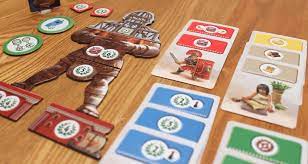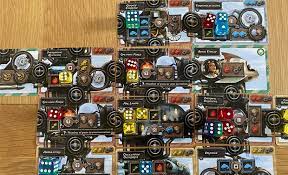Making your players feel smart by using combos and chaining
I recently played Ganz Schon Clever (That’s Pretty Clever) with some friends for the first time in a few years and I had forgotten how fun and interesting this game was. I was fortunate to get my own copy from a friend who was culling his collection shortly after this. This game definitely makes you feel smart and clever, as it allows you to chain together a bunch of rewards and unlock some interesting combos.
This got me thinking about what people like about board games and the feelings you get from playing them. Some games focus on the social experience, the camaraderie, or simply getting people to laugh and have a good time. Other games are about accomplishing a goal or like the topic of this article, making players feel smart.
Players feel smart when they have figured something out, particularly if it leads to some sort of reward, whether it is unlocking an ability, gaining more points, or advancing further in the game. This can be accomplished by solving a puzzle, figuring out where to place a piece, the perfect timing for playing a card/using an ability or discovering an awesome combo.
So, we’re going to talk about some games that make players feel smart by using combos and chaining things together, as well as how you can implement some of these ideas into the games you’re designing.
Ganz Schon Clever – Checking Off All the Boxes
We’re going to start off with the game I already mentioned, Ganz Schon Clever, as it is a great example of a game that allows you to chain together several moves and figure out some really cool combos.
This is a roll and write game by Wolfgang Warsch, who is also the designer behind The Mind, The Quacks of Quedlinburg, and Wavelength. In Ganz Schon Clever, one player rolls six dice and chooses one to keep and crosses off a corresponding box on their scoresheet. However, any dice with a lower value get placed on a tray and will become available to all other players at the end of the round, while the rest get re-rolled. This action repeats and the active player can claim up to 3 dice total. Then, the other players choose one die from the centre to score on their own sheet.
The clever part comes from deciding which dice to take and where to use them. Each die is a different colour and scores in its own unique way, with a colour for each section on your scoresheet. In some cases, you simply cross off a box with an X and at the end, you’ll score based on completed rows, columns, or how many total boxes you were able to cross off in a section. In other rows, you fill in a number based on the die value and sum these up at the end of the game.
As you get further along in the game, you’ll trigger rewards when you complete rows or place dice in certain spots. This can lead to chaining together rewards, where for example you cross off a blue 3 that completes a row, which gives you an orange 5. You place that orange 5 and it may allow you to cross off any yellow box. You decide to cross off a 2, which completes a row, triggering a green X. You then cross off a green box, which gives you a free die to choose from the pool, and you use this to cross off a purple 6 box to get another score.
It feels really good when you see that if you do this, then you get to do that, which also triggers some other thing. You can see how clever it can feel to chain one event into the next and try to figure out how many boxes you can complete in one go!
At the end of the game, you tally up your points in each section, along with any foxes you completed, which are a sort of multiplier for your lowest scoring section, and come up with your total. This allows you to try different strategies in each game.

I Wonder About Steam Punks…
It’s funny. Although I really appreciate a good combo or the ability to chain together a number of cards or actions, I don’t actually own a lot of games that do this.
One recent acquisition, 7 Wonders Architects, does have some elements of this. When you collect 2 of the same or all 3 different progress cards, you immediately swap them for a progress token. Also, most monuments have a set of rewards that are triggered when you complete a layer. The abilities on these tokens and monuments vary, but some of them allow you to perform additional actions in different situations.
For example, you may earn a token that allows you to take an additional card every time you pick up a specific card or complete a layer on your monument. The rules aren’t clear to me whether you’re allowed to chain these actions together, but it doesn’t appear there is any restriction. So, if you have a token that allows you to draw another card every time you pick up a gold card, using this action to pick up another gold card if it is available, would trigger this again, letting you draw another card.
While it’s not likely you’ll be able to do this too many times in a row, you may be able to earn some additional actions. This could allow you to progress much more quickly, perhaps even triggering another event such as drawing a card when you complete a layer of your monument.

Steam Punk Rally is another game that I really enjoy that allows you to pull off some interesting chaining of actions. This is a racing game where you’re actually building your vehicle as you advance. You place dice on different contraptions to activate other actions, such as movement, adding shields, removing dice, and earning more dice. The action of earning more dice can allow you to chain together several interesting moves.
For example, you may only have two red dice at the start of your turn. But if you roll a high enough number, you may be able to place one of these red dice and earn 2 blue dice. Then you roll the blue dice and place one of them in a manner that earns you a movement plus a yellow die. You can see how having the right parts on your vehicle can trigger more and more interesting actions.

Applying Combos and Chains to your own Games
As you can see, it can be exciting for players to figure out ways to turn one action into many. It’s like you’re getting a huge bang for your buck. So, you might be interested in finding ways to apply combos and chaining in your own game.
Like anything you are considering adding to your game, you have to be careful. You can’t just cram something in that makes no sense or adds a lot of clunkiness to your game. You also have to be careful not to overdo it. It’s all too easy to try to add in cards and events that lead to another action, but what can happen is a turn that is way too powerful or the worst-case scenario, an infinite turn. Yes, you want players to be able to find ways to unlock multiple actions on their turn, but there needs to be an endpoint.
As usual, a lot of this comes down to playtesting. You can add in or build around this idea of combos and chaining actions together but you need to see how it works in reality. You don’t want to make it too easy or too hard to pull this off. You need to find the right balance.
It should be a bit of a build-up. Players shouldn’t be pulling off crazy combos on their first or second turn. Make them earn it.
If players can connect the dots and see that if they follow a particular strategy they may be able to pull off something awesome, it will give them something to strive for. Look at what actions will trigger others and make sure that players can accomplish something fun without breaking the game. It will come down to a lot of playtesting and balancing.
As you’re working on your game, ask yourself, “What would I like to pull off here?” and find ways to do this. Also, listen to your playtesters and ask them what they wish they could do in different circumstances. This will give you even further ideas to test.
Wrapping it up
You can create some memorable moments and experiences in your game by finding ways to allow players to combo cards and actions or chain them together in some special way. This can definitely give your players the feeling of being clever or even powerful if they can chain these actions together.
Looking through my game collection, I realize that I don’t actually have that many games that use a lot of combos and chaining, however, I really do enjoy games that get this right.
What game do you enjoy that allows you to pull off a lot of interesting combos or chains?
Please leave a comment and let me know, as I’d love to learn about more games that do this well.

2 comments
Taylor
Great stuff, Joe! Some games that come to mind are Ultimate Railroads, Grand Austria Hotel, and New York Zoo.
Joe Slack
Thanks, Taylor! I appreciate the suggestions as well. New York Zoo is one I’d like to try soon.